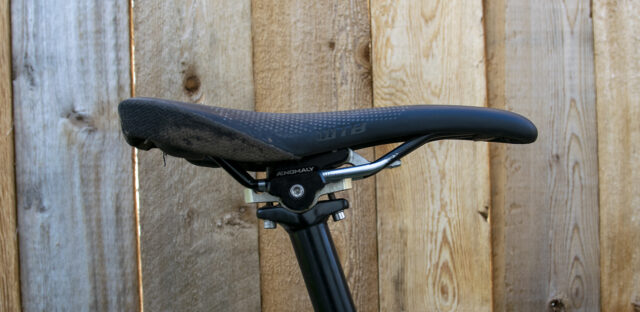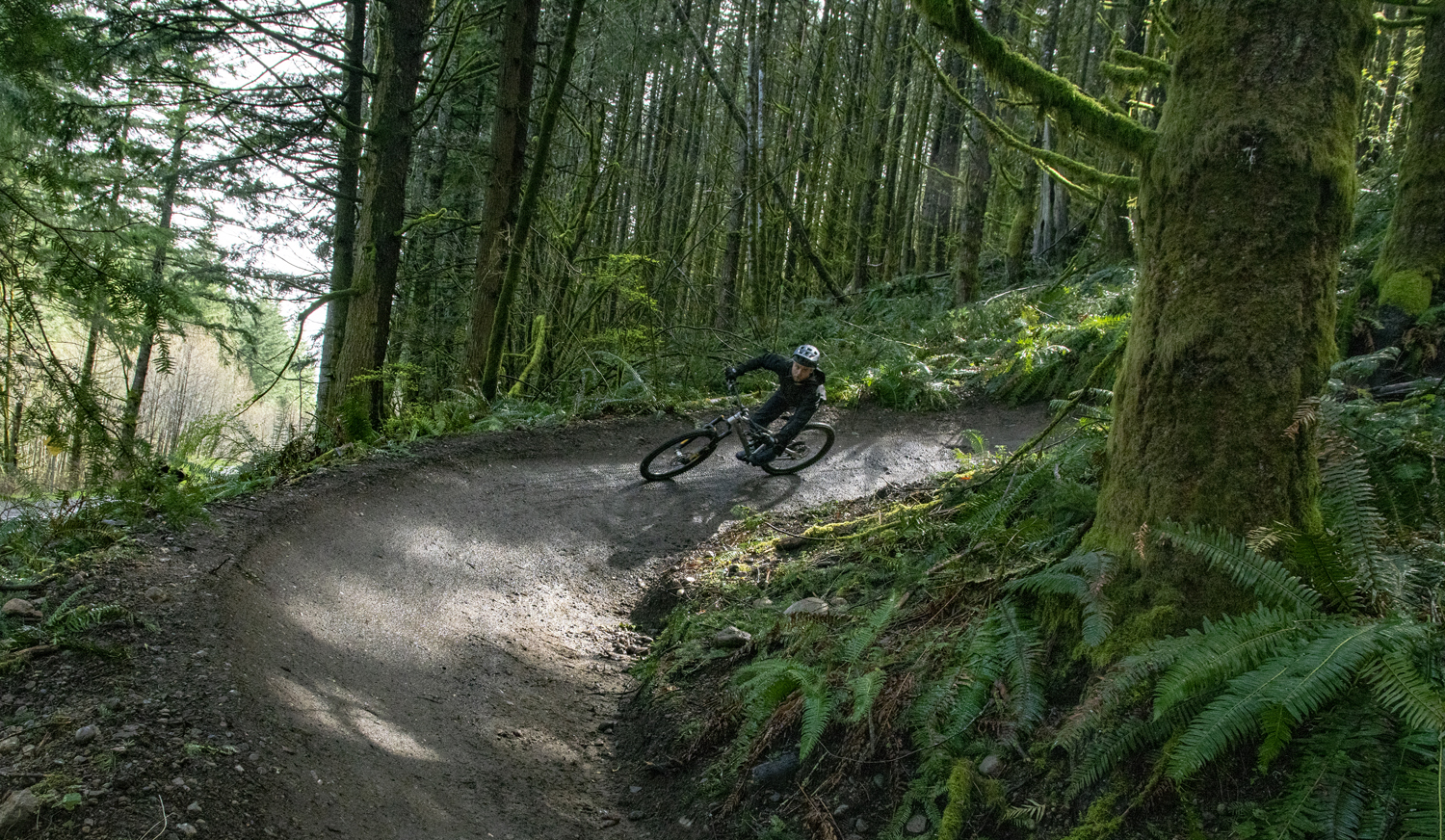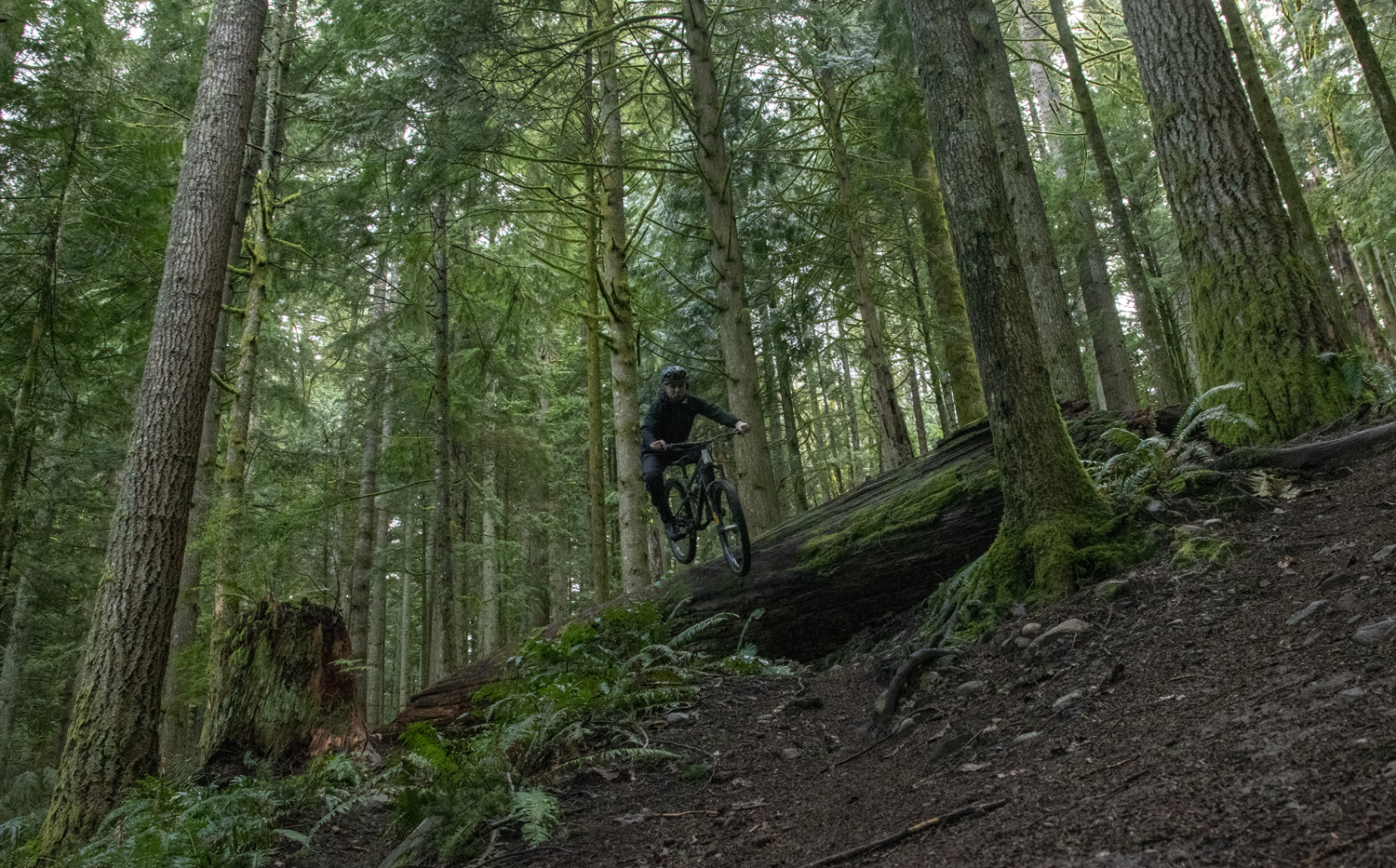Aenomaly Switchgrade Seat Angle Adjuster
Blister’s Measured Weight:
- Switchgrade: 165 g (base unit) + 27 g (hardware)
- Net Weight Gain: 121 g
Configuration Tested: Type 1 (for OneUp dropper, and others; see below for details)
MSRP (as tested): $245
Test Bike: Nicolai G1
Reviewer: 6’, 170 lbs / 183 cm, 77.1 kg
Test Location: Washington
Test Duration: 2.5 months

Intro
Look around the pits at a DH race, and just about every bike there will have the seat angled significantly nose-up. And there’s a good reason for that — doing so drops the back the seat for better clearance while still leaving the nose higher for support and stabilization, and the nose-up angle helps guide you back onto the seat, instead of getting caught behind it when hanging way off the back of the bike in the steeps.
The problem, of course, is that pedaling anywhere with the seat raised and the nose up feels terrible. That’s fine on DH bikes, where the seat won’t ever be raised, but what if folks on Enduro bikes could join in the fun, without having to take out a multi-tool for a trailside adjustment? And if that’s possible, wouldn’t it be nice to be able to drop the nose for super steep climbs, too?
Noel Dolotallas thought so and invented the Switchgrade to make it happen. And having now spent a few months with one, I think he’s right.

Design & Options
In short, the Switchgrade is a fancy saddle clamp that replaces the clamp bits on a whole lot of different seatposts, and lets you toggle between three different seat angles from a lever underneath the nose of the seat. To move between the three, you lift the lever and push or pull on the nose of the seat to move it into position; release the lever and it snaps into place. It sometimes takes a little wiggle of the seat nose after you’ve released the lever to fully seat, but it’s a quick and easy toggle and can be done while on the bike with a little practice.
[Aeonomaly’s site also mentions that you can flip the Switchgrade around and run the lever at the back of the seat if you want, but it hadn’t occurred to me until I read that blurb that anyone might want to. Up front makes way more sense to me, but I guess it can’t hurt to have the option.]
The three positions are “flat” (or however you choose to set it up), 10° nose down for climbing, and 12° nose up for descending (both relative to the flat position). The Switchgrade is compatible with most dropper posts that use a two-bolt style head (the Thomson style, for folks who are old enough to remember when that wasn’t the default design). There are four different versions to suit different posts; check the Aenomaly website for full compatibility details, but they’ve got most of the major options covered. The base Switchgrade units are available in black or black and gold, with seat clamp parts available in a bunch of other colors separately, if you want to get matchy-matchy.

The Switchgrade uses the two-bolt interface to set the saddle angle (in the flat position) as normal, but clamps the saddle rails using a third bolt that runs horizontally across the post. But before you have flashbacks to the terrible slip-prone single-bolt posts of old, fear not — the seat clamps are keyed into the main body of the Switchgrade and can’t rotate. If anything, the Switchgrade is easier to work on and install than a normal two-bolt seatpost — you install the Switchgrade itself without the seat in the way, making access to the barrel nuts that secure it much easier, and then snug up the seat with the third bolt. And as a bonus, seat angle and fore-aft adjustments are totally independent.
The Switchgrade unit is impressively compact, but it does still add a little bit of height to the seatpost. In the case of the OneUp dropper that I tested with it, it adds about 12 mm, but the OneUp has an unusually low-profile stock clamp; on most posts, the added height will be even less. The added weight is also modest; the Switchgrade itself weighs 192 g with hardware (in the version tested) but replaces 71 g worth of stock clamp parts for a net gain of just 121 g.
Unfortunately, the Switchgrade is a touch too compact to work with my long-time seat of choice, the Selle Italia SLR. It bolts up fine, but the clearance between the Switchgrade and the shell of the seat is tight enough that they make contact once you sit down and flex the shell, causing an uncomfortable hot spot. But in fairness to Aenomaly, the SLR is both an exceptionally low-profile seat and one that’s really designed for road bikes. I tried the Switchgrade with a handful of other seats from WTB, SDG, Ergon, and Fizik, and those all fit fine — it’s really more of an SLR problem than any major limitation of the Switchgrade. On the note of compatibility, the Switchgrade works with seats with 7 mm round rails (i.e., the vast majority of seats out there). Oval rails (typically found on carbon-railed seats) and 9 mm tubular rails are no-gos.

On The Trail
From a mechanical standpoint, the Switchgrade works great. It’s easy to operate and can be moved while on the bike (especially toggling between flat and climb modes) with a little practice. Going into descending mode on the bike is a little tricker, but it’s probably best saved for when you’re about to drop into an extended, steep descent anyway — if you’re in rolling terrain where you’re toggling your dropper a lot, the flat mode is a better bet. And it’s been totally solid in my time on it thus far — there’s essentially no play in it, and it’s shrugged off at least one notably hard landing to the seat without complaint.
I did an A/B/C test of a 210 mm drop OneUp post on its own, the same post with the Switchgrade, and the 240 mm version of the OneUp dropper on its own on my Nicolai G1 (I don’t have enough height to work with to pair the longer dropper with the Switchgrade). Just from the standpoint of descending feel, the 210-drop + Switchgrade combo is my favorite. Even the 210 mm OneUp post on its own affords a lot of clearance, but getting the back of the seat lower helps even more while also reducing the angle of the back of the seat, making it less likely that you’ll get hung up on the back of the seat when getting way off the back of the bike in super steep terrain. And compared to the 240 mm drop post, it also has the benefit of keeping the nose of the seat higher, putting it in a better position to steady the bike against the inside of your leg while descending. I genuinely didn’t realize how much I did that until I ran this little experiment, and thought hard about why the Switchgrade felt better — but I really think that’s a big part of it. The 240 mm drop post gives me all the clearance I could ever want but also makes the seat a bit less useful for steadying against my legs, and borderline too low to pedal on when seated (in part because my left knee is a bit short on range of motion).
As I said up top, there’s a reason World Cup DH pros set their bikes up like that (and it’s not just that it looks cool). Having the seat a bit nose-up is genuinely nice for descending on very steep trails, and the Switchgrade makes it possible on bikes that are going to be pedaled back up to the top without major compromise. And it’s a real boon on the way back up, too — at least if the climb is steep enough.
Aenomaly says that the nose-down climb position also helps keep your weight forward on the bike when climbing, and reduces pressure from the nose of the seat on the way up. And it does. But at least for my personal preferences and anatomy, the threshold for how steep a climb has to be before the nose down position feels natural is pretty high. On flatter terrain, the nose-down position causes you to slide forward on the seat and put more pressure on your hands to resist that tendency. Once things get steeper, it balances out — and does eventually feel really nice, once the climb gets steep enough — but I think it would be more useful, more often, if the nose-down angle was moderated a bit.
I did experiment with setting up my “flat” position to slightly nose up with that goal in mind, and it did indeed make the “climb” position more usable. But it also meant that the “flat” mode became uncomfortable on even fairly gentle climbs, which in turn meant that I needed to toggle the Switchgrade a lot more frequently if I was on anything other than a super long, sustained climb. Depending on where you’re riding, that might be a totally viable option, but I personally prefer to leave the “flat” mode truly flat, and just accept that I’m going to use the climb setting somewhat less frequently. But it’s still there if I want it, and apart from the extra 90-some-odd grams (on a bike that’s… let’s just say not light), there’s really no downside to having the Switchgrade installed. And for the benefits on the way back down, plus the odd mega-steep climb, I’m more than happy to put up with a little extra weight.
The Switchgrade is a really nicely made (in Canada), very clever product, and while its appeal might be somewhat niche, I think it’s of very real benefit to at least certain riders — particularly folks who spend a lot of time in very steep terrain.

Bottom Line
The Switchgrade is going to be of most benefit to riders who are spending a lot of time on very steep trails — both up and down — and for those folks, it’s genuinely useful. Descending with the seat nose-up is great, and the Switchgrade makes very steep seated climbs more comfortable, too. And there really aren’t any major downsides to having one — a few grams and a little extra seatpost stack height (which will only matter to people who are right on the edge of having enough insertion depth in their given frame / post combination) are about it, once you set aside the price of buying one. While the cost won’t be worth it for everyone, it’s a genuinely well-designed, well-made, worthwhile product — and one that I’ll be keeping on my personal bike now that I’m done reviewing it.

“two-bolt style head” — you mean the Syncros style, for folks who are old enough to remember that Thomson didn’t do it first? ;)
Thanks for the great review, I’m super keen to try the switchgrade
Haha, damn it. I definitely had a few of those Syncros posts back in the day, but it’s been long enough that I’d apparently forgotten about them.
all in good spirits, love your work.
I just pulled the trigger on a switchgrade, it’s on pre-order but i’ll jump in with further thoughts once it arrives and i’ve had some time on it. As someone who mostly rode DH back in the day, it always bothered me that droppers don’t adjust tilt too. Looking forward to mounting this small but expensive solution to one of my pet peeves
I’ve got a Switchgrade on order that should be arriving in the UK next week. I’m really exited to see if it lives up to my expectations as it looks like a brilliant addition to the dropper post on my bike, I have some really steep climbs and descents on my local trails and I think the Switchgrade will really work well for me.
I’m old enough to remember IRD was doing two-bolt style seatposts ~5 years before Syncros…
http://www.bikepro.com/arch_products/seatposts/aird.html
http://mombatbicycles.com/MOMBAT/BikeHistoryPages/Interloc.html